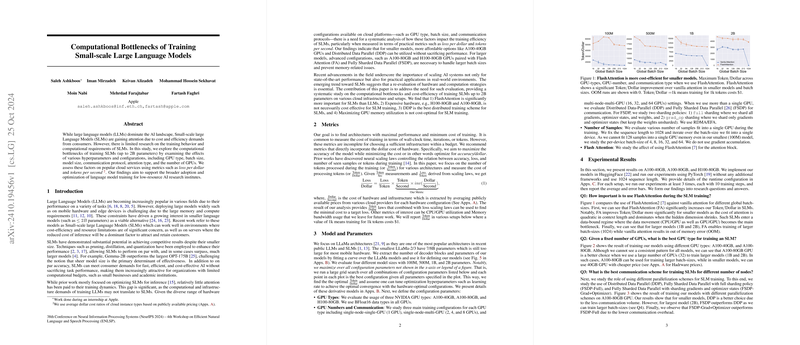Analyzing the Computational Bottlenecks in Training Small-scale LLMs
The paper "Computational Bottlenecks of Training Small-scale LLMs" addresses an emerging area of research in the field of artificial intelligence, specifically focusing on the training dynamics and computational challenges of Small-scale LLMs (SLMs) with up to 2 billion parameters. This work examines various hyperparameters and hardware configurations, crucial for optimizing SLM training, particularly in environments constrained by computational resources and budget.
Key Findings
The research identifies several bottlenecks and offers recommendations for effective training:
- FlashAttention Significance: FlashAttention (FA) is highlighted as a critical component for enhancing cost-efficiency in training. The data suggests FA is particularly advantageous for smaller models due to its impact on data movement bottlenecks. The use of FA allows for larger batch sizes without the risk of out-of-memory (OOM) errors, a limitation often encountered with vanilla attention mechanisms. This is particularly relevant given the quadratic computational complexity of attention operations.
- Hardware Configuration: The paper compares different GPU types, revealing that A100-40GB GPUs are sufficient for smaller models, while A100-80GB GPUs are preferred for larger models and configurations with many GPUs. Noteworthy is the finding that more advanced and expensive hardware, such as H100-80GB GPUs, do not necessarily provide proportional cost benefits for SLMs, emphasizing a nuanced approach to hardware selection.
- Distributed Training Schemes: Analysis of communication strategies concludes that Distributed Data Parallel (DDP) is most effective for smaller models, while Fully Sharded Data Parallel (FSDP) shows advantages for larger configurations. The benefits of FSDP, particularly the Grad+Optimizer variant, are largely due to reduced communication overheads, enabling efficient scaling with fewer resources.
- Optimization Metrics: The paper proposes using "loss per dollar" and "tokens per dollar" as metrics to evaluate training efficiency. These metrics incorporate both model accuracy and financial cost, offering a practical framework for research institutions operating under budgetary constraints.
Implications
This research provides critical insights into the resource-efficient deployment of SLMs, which can cater to environments with limited computational budgets, such as small businesses and academic institutions. The findings advocate for adopting training methodologies that challenge the prevailing focus on extensive hardware resources, shifting the narrative towards efficiency and accessibility.
Future Prospects
The implications of this paper are substantial, suggesting shifts in AI research and deployment strategies. As the landscape evolves, the adoption of SLMs is likely to expand, supported by hardware and software advances that further optimize cost-performance ratios. The exploration of additional metrics related to CPU/GPU utilization and memory bandwidth usage presents opportunities for future research.
Overall, the paper systematically unpacks the complexities of training SLMs, providing a significant contribution to the discourse on cost-efficiency in AI. The emphasis on targeted hardware choices and innovative attention mechanisms anticipates a landscape where smaller, efficient models play a vital role without compromising on performance.
